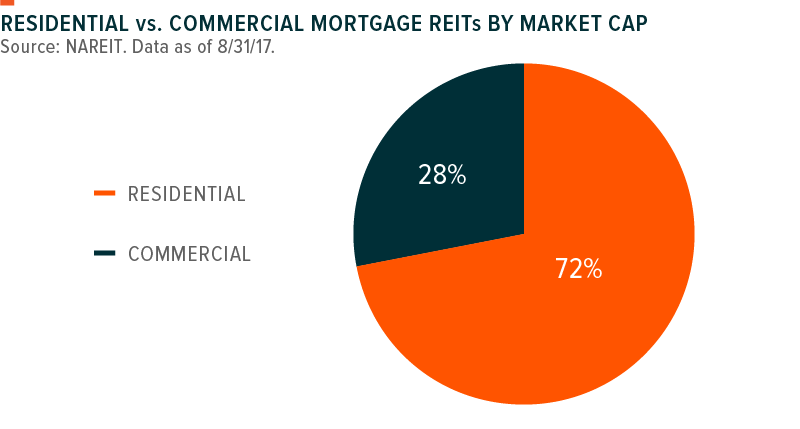During this prolonged low interest rate environment, many investors have considered adding exposure to Real Estate Investment Trusts (REITs) to potentially improve the yield characteristics of their portfolio. Within the REIT asset class, however, there are two broad types of REITs—Equity REITs and Mortgage REITs (mREITs)—with very distinct characteristics. In this piece, we seek to shed light on the mREIT portion of the market by addressing the following questions:
- What is a mortgage REIT?
- What is the typical mREIT business model?
- What are the risks associated with mREITs?
- What is the outlook for mREITs?
What is a Mortgage REIT?
MREITs are a relatively small portion of the overall REIT market, making up just 6% of the asset class with $67 billion in total market cap.1 Despite falling under the REIT umbrella, mREITs are often analyzed separately from equity REITs due to differences in asset bases, business models, and funding profiles. In this vein, the Global Industry Classification Standard (GICS) classifies equity REITs in the ‘Real Estate’ sector, while mREITs land in the ‘Financials’ sector.2
While equity REITs invest in physical properties, mREITs invest in mortgages or mortgage backed securities (MBS), making them real estate debt owners. Within the mREIT space, these entities tend to either focus on residential mortgages and mortgage backed securities (RMBS) or commercial mortgages and mortgage backed securities (CMBS). The size of the residential mortgage market has historically been larger, making residential mREITs more prevalent than their commercial-focused counterparts.

What is the Typical mREIT Business Model?
MREITs typically derive their returns from the income produced by the mortgages in their portfolio as well as changes in the mortgages’ net present values (NPV). This is not dissimilar to equity REITs, which derive their returns from rents paid by tenants and the changes in its properties’ valuations. Mortgages, however, tend to be much more liquid than physical properties, allowing mREITs to more nimbly manage their exposures by geographic region, property type, credit risk, and interest rate risk. Given this flexibility, many mREITs operate more like a bond fund manager than a property owner, actively turning over their portfolio of mortgages and exposures to respond to changing market conditions and expectations. Another feature of mortgages is that they repay their principal (barring a default), while physical properties can have uncapped gains or become worthless.
To finance the purchase of mortgages, mREITs mostly borrow via short-term debt securities like repurchase agreements (repos) or raise equity. Given their heavy reliance on borrowing, mREITs focus on the spread between their cost of debt and the income received from their mortgage holdings. The wider this spread, generally the more profitable it is for the mREIT. As an illustration of this spread, the current difference between the overnight repo rate and 30-year mortgage rate stands at 2.78%.3

Another important measure is the amount of debt taken on by an mREIT, given that this leverage acts as a multiplier. MREITs, for example, currently exhibit an average debt-to-equity ratio of 4.3x, which when multiplied by the repo/30-year mortgage rate spread of 2.78% results in an effective spread of 11.95%.4
For any mREIT, their goal is to maximize this effective spread while managing associated risks. To do so, mREITs have a few key levers they can adjust to affect the effective spread or exposure to specific risks. These levers primarily include:
- Interest Rate Risk/Duration: how long are the mortgages they are buying (e.g. 5 year, 10 year, 30 year)? Longer mortgages tend to pay a higher yield but also have more interest rate risk.5 MREITs can fine-tune their duration risk6 by using derivatives like interest rate swaps. Derivatives have their own risks, though, such as potentially higher volatility than their underlying assets and counterparty risk.
- Credit Risk: how risky are the mortgages they are buying? Riskier mortgages tend to pay a higher yield, but are also more likely to default. MREITs can choose to focus on higher quality agency mortgages that have quasi-government credit risk or target lower quality non-agency mortgages issued by private institutions like banks. MREITs can also fine-tune credit risk exposure using credit derivatives like credit default swaps (CDS).
- Leverage: how much debt does the mREIT use to purchase mortgages? Higher leverage can increase the effective spread, but also magnify other risks.
These levers can vary significantly from mREIT to mREIT depending on their risk tolerance or views on interest rates and the macro environment. As an example, we show two different mREIT profiles below: Annaly (NLY), the largest mREIT, and Ellington (EARN), one of the smallest based on market cap within the FTSE NAREIT Mortgage REIT Index.

Rather than focusing only on the interest rate spread, mREITs can also elect to use their expertise to try capture changes in the net present values of various mortgages. If mREITs only relied on the interest spread for income, one would expect their performance to be positively correlated with changes in interest rate spreads. Yet the chart below shows that this has usually not been the case as there are years where the spread has shrunk while mREITs delivered positive returns. This can be due to mortgages appreciating in NPV.

What are the Other Risks Associated with mREITs?
Below is a summary of some of the other additional risks that can affect the performance of mortgages or mortgage REITs:
Prepayment Risk: Falling interest rates or greater interest rate volatility can accelerate the pace of mortgage refinancing. This can change the duration characteristics of a portfolio of mortgages as well as cause reinvestment risk, where mREITs must reinvest repaid principal at a lower rate than before.
Extension Risk: the flip side of prepayment risk occurs if interest rates rise and homeowners remain in their existing mortgages longer than anticipated. This can have a negative effect on mortgage values because homeowners lock in their low interest rate for longer.
Hedging Risk: mREITs often use hedging instruments in an effort to control for various changes in interest rates, credit risks, and macro scenarios. The value and accuracy of these bets can have a material effect on bottom line profits.
What is the Outlook for mREITs?
Although each mREIT has a unique portfolio of mortgages and varying exposures to certain macro risks, there are specific environments that have been particularly positive for the broad universe of mREITs. First, mREITs tend to benefit from low levels of interest rate volatility because this reduces prepayment risk. The chart below shows that historically mREIT performance is negatively correlated to interest rate volatility.

Second, as discussed before, mREITs tend to benefit from wider spreads between their borrowing costs and the yield on their mortgages.
An environment that tends to be negative for mREITs is when there is a parallel shift in the yield curve. The higher interest rates cause the NPV of the mortgage portfolio to fall while extension risk also becomes more likely. A flattening of the yield curve is also a negative for mREITs from an interest spread perspective as it can reduce, or even negate the duration risk they take on. For these reasons, some mREITs may extensively hedge the risks of a rate shift.
Putting this all together, a generally positive environment for mREITs should occur when interest rates are stable and there is a healthy interest rate spread. A potential opportunity and risk to the mREIT space will present itself over the next few years as the US Federal Reserve begins to unwind its $4.5 trillion balance sheet. This “policy normalization” will spur the Fed to begin rolling off their $1.8 trillion in agency MBS assets. The Fed has consistently stated that this process will be gradual to avoid any unexpected volatility. Given the Fed’s substantial ownership of MBS, policy normalization is likely to have a widening effect on MBS spreads. Assuming the Fed can keep interest rate volatility low, various mREIT management teams believe widen spreads will present significant opportunities.
Related ETFs
SRET: The Global X SuperDividend® REIT ETF invests in 30 of the highest dividend yielding REITs globally.
SDIV: The Global X SuperDividend® ETF invests in 100 of the highest dividend yielding stocks in the world.
 Rohan Reddy
Rohan Reddy